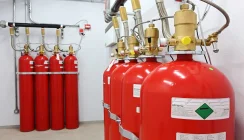How to Reduce Fire Risks Within Computer Rooms
Many organisations today run an on-site server room and even with the growth of Cloud-based services and hyperscale data centres will continue to do so. Somewhere within the building, businesses and organisations need an IT facility to process and store data locally as well as connect them to external IT services and SaaS platforms.
The equipment within these server rooms and the data being processed represents an expensive investment and one that needs protection. Whilst uninterruptible power supplies provide critical power protection for peace of mind and continuous operation in the event of momentary or complete mains power supply failures, a fire suppression system provides immediate protection and the suppression of a fire within the facility.
One of the reasons a fire is a threat within a server room or data centre is the amount of power being drawn by IT servers and their CPUs (central processing units) and the heat generated. A high-power density server rack can draw from 10-30kW of power and at 95% efficiency this can see up to 1.5kW of heat that must be cooled. If the cooling system fails to maintain a 20-25˚C ambient, thermal runaway and fire becomes a real issue.
The most common causes of server room and data centre fires include:
- Electronic and electrical component overheating
- Equipment failure and short-circuits
- Poor design with under raised access floor wiring and cooling issues
- A lack of environment and temperature monitoring within racks to identify ‘hot-spots’
- Fire spread from outside the room and other parts of a building
- A build-up of dust and dirt sources leading to electrostatic discharges and sparks
Even the storage of waste packing and shredded paper within the server room or data centre should be managed or avoided to remove a potential and flammable fuel source from the area.
One of the first steps you can take to protect a server room or data centre is to carry out a fire risk assessment. Often this is best carried out by an external consultant. Not only will they bring an external view which may see the ‘obvious’, but they are trained and certified and will look at your site from a ‘best practice’ point of view to identify fire hazards and how best to protect form them.
Based on the findings of the fire risk assessment there will be the need to put in place protection measures. These could cover:
- Fire Suppression System Review: to install or upgrade an existing fire suppression system. One of the key choices here is whether to use a gas other synthetic gas suppression system. Fire suppression systems that use a gas can reduce oxygen levels within the room to below the level required for ignition and burn i.e. 15%. The type of gas could be argon or nitrogen. This type of system should not reduce oxygen levels below 12% in order to protect any people left within the vicinity who should have been evacuated or will need immediate removal from the area. Synthetic gas fire suppression systems do not reduce oxygen levels and use advanced cooling mechanisms to remove to remove heat from the area.
- Adopt Fire Prevention Measures: other fire suppression related measures can include the addition of smoke and fire detectors in the area, as well as an overall fire suppression control system, audible alarms and the use of flame-retardant panels. Early detection of any fire related incident allows for a greater chance of suppressing a fire before it can take hold. Detectors can include lasers, ionization and heat sensitivity that can identify very low levels of smoke and heat. The use of flame-retardant panels can help to contain a fire and stop it spreading to another room. When used within a server room, these panels can help to contain a fire within the room or protect the room itself from a fire elsewhere in the building. Flame retardant panels offer a high degree of protection for a limited amount of time. They do not provide complete protection to extreme temperatures over a sustained period-of-time. Care should therefore be taken to select the most appropriate specification and to use these types of panels as a secondary form of protection and barrier. In addition for panels to work effectively their construction and design must not be weakened through holes made for cabling and trunking. Any such holes must be plugged and sealed with flame retardant filler.
One final note is that a fire suppression system should be installed alongside an appropriately sized cooling system with N+X resilience. Over-heating and cooling system failure are two of the most common causes of fire within a server rack or data centre environment. Server rack temperatures can rise quickly to ignition points during a cooling failure and provision should be in place to either shutdown operations using an emergency power off (EPO) facility or bring additional cooling into place, even if this is temporary and portable.
Summary
No matter what the size of server room or data centre, the concentration of high computing and power electronics provides the perfect opportunity for a fire-related disaster due to unmanaged ‘hot-spots’ and the amount of electrical power being drawn within a confined space. Having a well-designed and maintained fire suppression system may be mandatory for insurance purposes but should also be installed as part of a disaster mitigation plan. Where it is not practical to install a complete system, an in-rack fire suppression tray may be more practical, even for a single server rack in remote or unmanaged environments.

























